With the return of marathon road running this weekend in the London Virtual Marathon, Eoin Flynn asked me had I any thoughts on the matter of carbon-plated shoes to share with our readers?
“Yes, strong ones,”I replied. Yet I am not a shoe guru. Shoes are one of the aspects of running that interests me the least. As a coach I need to know a bit of everything, but my focus is on the training and not the equipment. What interested me in answering Eoin’s question is the implications the shoes have for the sport overall – not the technical details of the shoes themselves.
Do not take my opinion here as any kind of judgement on anyone who is already running in this type of footwear and enjoying it. I totally understand where you are coming from and, in fact, if I decided to return to road racing at some part of my own master’s career, you can be pretty sure that I would be wearing the carbon-plated shoes.
Why? Well, for me road racing is about pure competition so you cannot afford to be at any disadvantage. If I run a 5 km race in a pair of non-carbon plated shoes then I stand to lose somewhere between 40 and 80 seconds on people with a similar fitness level – that is, of course, if the shoes work exactly like advertised and if they work that way for everybody. This is the view espoused by our own Irish international Stephen Scullion: ‘if you don’t wear them, don’t expect to be competitive’.
With that caveat out of the way let us dive into the issue of carbon-plated shoes. I would be grateful if anyone reading this considers it the beginning of a discussion – not the attempt at a final word on the matter.
Quick background
The carbon-plate controversy began with the advent of a shoe called the Nike Vaporflywhich has since spun off newer models and rival shoe companies like Hoka have followed suit. Today there is even talk of the first carbon-plated running spike for track racing. The benefits are claimed to be around 4 to 7% – the equivalent of dropping your marathon time from 3 hours to 2:53 (4%) or 2:47 (7%). In reality, the actual improvement for an individual remains murkier.
I am taking it at face value here that the shoes provide the benefit they claim (4% in early models and 7% in later ones) for some (but not all people). Obviously, if the scientific research proving this is found to be flawed and the real benefit is lesser than we are discussing a ‘made-up problem’ here but it’s beyond the scope of this piece to review the science.
This has created an enormous ripple through the running community going as far as threatening the diversity of the shoe market where elite athletes are abandoning brands like ASICS and Mizunoin droves and tightening Nike’s hegemony on the running market.
Better ban them?
Personally, I believe the running world would be better off if carbon-plated footwear was banned. That is a strong opinion and I want to qualify why I hold it. I am not simply a ‘Luddite’ who wants to hold back technological progress at all costs. I own a Garmin.
But who am I really to disagree with Kipchoge who succinctly says: “We must all accept technology and move on.”
He is right in many ways. If technology is implemented, then we must all accept it and move on. Or be left behind.
I do not expect carbon-plate footwear to go away but here are the reasons I believe they are problematic. I do not want to stir up a hornet’s nest here as much as I want to stir up a bit of discussion on the topic.
Reason #1: It shifts the focus from athlete to equipment
We have sports that are heavily focused around equipment (from formula 1 at one extreme through cycling somewhere in the middle to ‘pure’ sports such as running and eventually martial arts at the other extreme).
My first concern is we have seen a shift in conversation from talking about the athletes to talking more and more about their footwear. This should never be the case in running where the main star should always be the runner. The shoe sponsor should reflect in their glory rather than the athlete being an accessory to the latest shoe.
It creates the situation where any runner who is beaten by a fellow competitor wearing a carbon-plated shoe can’t help but reach the finish line thinking ‘did I just get beaten by the shoe, or the person?’ and where anyone breaking their old PBs must wonder ‘would I have beaten my best in my old regular runners and does that mean I have really gotten any better at all?’ I know history only remembers the times we ‘put on the board’ but personally I would feel somewhat ‘bittersweet’ about a ‘carbon-aided PB’.
Previous iterations of running shoes – while offering improvements, where never ascribed as much credit for breakthrough performances. The difference between shoe models was always ambiguous enough Now you have a situation where athletes sponsored by other shoe brands will spray paint a Nike Vaporfly so they can gain the advantage of that shoe without offending their sponsor.
Reason #2: It raises awkward questions about improvement, record-breaking and the nature of ‘enhancement’
We may say that ‘technical’ running shoes supposed to give us an advantage have been around since the early Sixties and general footwear obviously since Ancient times. So, what makes one technological step forward different from another? Why is carbon more ‘offensive’ than ‘EVA foam’?
The line to me goes when the technological advantage leads to the detriment of the sport. A good example is the technological step-backs taken by Formula 1 because certain features of cars made the races ‘too predictable’.
A second – more relevant – example was the 2010 ban on buoyant polyurethane swimsuits which led to the obliteration of long-held world records. It was felt then that this cheapened the sport and destroyed its history – lessening the value of ‘world record breaking performances’ (in a similar way to the many ladies’ records broken through the use of doping in Athletics in the 1980s). We have seen signs of this with many long-standing records being obliterated only for a large cohort of fans to point out that ‘it only happened because of the shoes’ and that the original record holder ‘performed better’ and other awkward questions that can tarnish the experience of ‘breaking a record’ both for the record-breaker and the fan.
Technology in this way can come to resemble a form of ‘technological’ or ‘mechanical doping’ and it opens an awkward discussion that chemical augmentation is morally wrong and reprehensible but technological enhancement is wonderful and laudable? I do not myself posses a clear answer to that question.
BUT, you may say: other technological improvements in athletics have already had this effect before, namely the synthetic track. It is well-known that modern polyurethane tracks are at least 1 second faster than the grass and cinder tracks widely used up to the late sixties. This means modern records look somewhat inflated compared to times run on the older tracks. This brings me to my third concern.
Reason #3: It creates an uneven playing field
The transition to polyurethane track was slow and gradual due to the expense of this technology but at least in any given race athletes were presented with a ‘level playing field’ (because everyone ran on the same surface). The best athletes in the world would eventually get access to the best tracks in the world. With carbon-plated shoes many runners will have different shoes – some with greater advantage than others. Running now more closely resembles Formula 1 – you still need the best driver to win. But you also need a superior car. You may win a race in a Ferrari but in a Lotus? Forget about it.
This would be less of a problem if the shoes were equally available to everyone. However, the modern carbon-plated shoes must be purchased at great expense costing nearly twice as much as regular running shoes and having a much shorter lifetime (so the price ‘per mile’ is many times that of a normal running shoe). In a capitalist society we accept that price should follow perceived value and in this way the shoes are obviously a success and some people are willing and able to pay for this. We also understand that more research means higher prices for a long period of time until the initial development cost is paid back. It’s possible this situation will improve although I see no definitive trends of shoe prices having a tendency to drop over time!
My main concern lies in the words some and able. One of the great attractions of running for many people lies in its simplicity ‘just put on your shoes and run’ and the perception that you ‘get out what you put in’. There’s a fundamental sense of ‘fairness’ and individual control embedded into the essence of running as a sport. You do not rely on team-mates and having the best equipment was long considered to make a negligible difference compared to, say, having the lightest carbon-fibre bike in cycling.
The carbon-plated shoes have changed this dynamic because now the best time will be run with those who are either willing, or more importantly able, to afford. Athletic prowess becomes not just about the work you put in but the investment of money you can make. Even for those wearing the shoes the effect is different as studies showed ‘responders’ and ‘non-responders’ – so we have a tool that benefits some people more than others (for details on this read here).
I know a counter-argument is that ‘if you want it enough you’ll prioritise your money’ but it’s beyond question that a 250-270 euro price tag will be more than some people can afford under any circumstances. These people can now find themselves at a disadvantage they did not previously have.
Perhaps this should not matter: because is not our sport about personal achievement? I would agree to an extent, but we cannot forget that place and position also matter and, even more so, our sense of personal achievement is not only derived from beating our personal times. It is based on how we judge our own achievements relative to everyone else. If the average times in races go down because of carbon-plated shoes, then the times of those without them will appear ‘less’ in comparison.
Conclusion
Weighing these three main concerns up against the benefits (faster times and potentially more public interest in the sport), I feel we would be better off putting carbon-plated footwear the way of the polyurethane swimsuitsand 3d silicone chevronsin road cycling.
How do we go about this in practice? It’s quite simple really, athletics should just ascribe more tightly to ‘technological doping’ definition as set out by WADA:
Technological doping is the practice of gaining a competitive advantage using sports equipment. The World Anti-Doping Agency (WADA) considers prohibiting technologies if they are “performance-enhancing” or “being against the spirit of the sport”. In 2006, WADA initiated a consultation on technology doping which is now officially recognised as a threat, whilst the decision to allow or ban a new technology, specifically relating to sports equipment, is the responsibility of each sport’s own governing body.
The primary concerns that drove the adoption of a definition of ‘technological doping’ are summarised on Wikipedia:
“people fear that sports engineering could: overshadow the triumph of human spirit and effort, make certain sports easier, create unfairness so the “best athletes” might not win, and ensure that rich athletes and countries have an advantage over the poor ones.”
This mirrors my basic concerns about what carbon-plated shoe will do to the sport of running. For the moment, I plan to keep my focus on the trails and cross-country, leaving me free from having to make the awkward choice of ‘whether to buy a carbon-plated shoe’ for another while.










